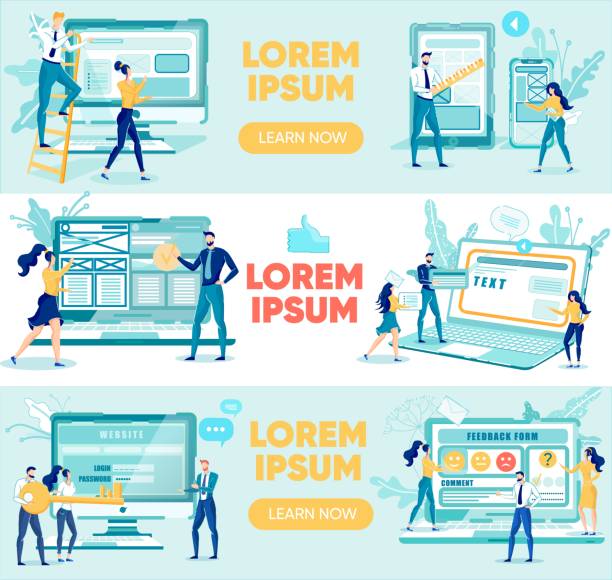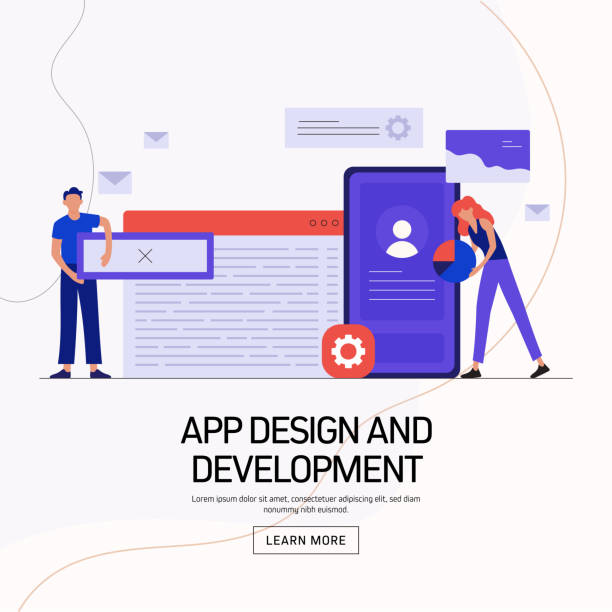Introduction to Fast Website Design: The Importance of Speed in the Digital World

In the current era where speed is paramount, fast website design is not just an advantage, but an undeniable necessity.
Internet users have little patience for slow websites, and a few seconds’ delay can mean losing visitors, customers, and ultimately, revenue.
In this explanatory section, we provide a comprehensive overview of the importance of website loading speed and answer why investing in website speed optimization is crucial.
Statistics show that more than half of users leave a website that does not load within three seconds.
This statistic alone speaks volumes.
Every millisecond of optimization in website speed can have a direct impact on conversion rates and user satisfaction.
From an educational perspective, learning the principles of fast website design is vital for every developer and online business owner.
This topic includes image optimization, CDN usage, code compression, and choosing appropriate hosting, all of which contribute to speeding up the loading process.
Overall, a fast website offers a better user experience, achieves a higher ranking in search results, and significantly contributes to your business success.
Our goal in this article is to provide practical solutions to achieve this.
Are you tired of losing business opportunities due to not having a professional corporate website?
Rasaweb, with its professional corporate website design, helps you:
✅ Build a powerful and reliable image for your brand
✅ Convert website visitors into loyal customers
⚡ Get a free consultation now!
Fundamental Principles of Building a High-Speed Website: Techniques and Tools

Building a high-speed website does not depend on a single factor, but rather a combination of multiple principles and techniques that together lead to a significant increase in loading speed.
In this specialized section, we will examine the fundamental principles of fast website design and provide guidance-oriented solutions for implementing them.
One of the most important principles is optimizing HTML, CSS, and JavaScript codes.
Removing extra code, Minification, and Concatenation can drastically reduce data volume.
Using Lazy Loading for images and videos is also very effective; this technique ensures that multimedia content is loaded only when the user needs it.
Choosing quality hosting with powerful servers plays a key role in the initial website speed.
Content Delivery Networks (CDNs) also ensure that content is delivered from the closest server to the user by storing copies of your website’s content on multiple servers worldwide, thus eliminating the impact of geographical distance on speed.
Additionally, Caching content in the user’s browser prevents static files from being reloaded on subsequent visits.
Understanding these principles and correctly applying them in the fast website design process is the cornerstone of an excellent user experience and ensures that your website always performs at its peak.
Technical Factors Affecting Site Speed: Deep Analysis and Optimization Solutions

To achieve fast website design, it is essential to accurately identify and optimize the technical factors that directly impact loading speed.
This section provides an analytical and educational in-depth examination of these factors and offers practical solutions to overcome common challenges.
One of the most important factors is image size and quality.
High-volume images can significantly reduce loading speed.
Using new image formats like WebP and compressing images without noticeable quality loss is a fundamental step in website speed optimization.
Setting the correct image dimensions is also important; an image that is too large, even if compressed, will increase loading time.
Another factor is the number of HTTP requests.
Each file (image, CSS, JavaScript) requires a separate HTTP request.
Reducing the number of these requests through file combination and using CSS Sprites can significantly increase speed.
Database optimization and its queries are also crucial for dynamic websites, especially those built on CMS platforms like WordPress.
Regular database cleanup and optimizing table structures improve overall website performance.
Additionally, using a Content Delivery Network (CDN) to distribute static website content on global servers, as well as enabling GZIP compression to reduce file size before sending to the browser, are other specialized techniques for fast website design.
These solutions collectively help create an agile and responsive website.
| Factor | Description | Effect on Speed |
|---|---|---|
| Image Size | High-volume images increase loading time. | Reduced Speed |
| HTTP Requests | Too many requests for different files. | Reduced Speed |
| Code Optimization | Excessive and uncompressed code (HTML, CSS, JS). | Reduced Speed |
| Hosting Quality | Slow or unsuitable servers. | Reduced Speed |
| Lack of CDN Usage | Lack of content distribution across different parts of the world. | Reduced Speed |
Website Performance Optimization Tools and Techniques: A Comprehensive Guide

On the path to fast website design, using appropriate tools and techniques for website performance optimization is crucial.
In this guidance-oriented and specialized section, we introduce some of the most important tools and techniques that significantly help you achieve high speed.
Tools like Google PageSpeed Insights, GTmetrix, and Pingdom Tools allow you to analyze your website’s performance and receive suggestions for improvement.
These tools not only display your website’s speed score but also identify specific issues such as high image volume, lack of GZIP compression, or slow loading of JavaScript resources.
One of the most widely used techniques is browser and server caching.
By enabling caching, the user’s browser can store resources such as CSS, JavaScript files, and images so that they don’t need to be re-downloaded on subsequent visits.
On the server side, using caching like Redis or Memcached can increase the responsiveness of databases and scripts.
Font optimization is also highly important.
Using modern font formats like WOFF2 and loading fonts asynchronously can prevent render-blocking.
Additionally, removing unnecessary CSS and JavaScript codes (Minification and Deferring) that are located above the fold helps improve the First Contentful Paint metric and enhances the initial user experience.
Focusing on these tools and techniques is an inseparable part of fast website design and ensures that your website always performs at its peak.
Are you worried that your company’s old website will drive new customers away? Rasaweb solves this problem with modern and efficient corporate website design.
✅ Increases your brand’s credibility.
✅ Helps attract targeted customers.
⚡ Contact Rasaweb for a free consultation!
User Experience and Loading Speed: An Unbreakable Link

Have you ever considered how your website loading speed affects user experience (UX)? This is a thought-provoking question whose answer can play a vital role in your online success.
In fact, there is an unbreakable link between speed and user satisfaction.
A website that loads quickly conveys a sense of engagingness, efficiency, and professionalism to the user.
Conversely, slow websites can quickly lead to frustration and site abandonment.
Imagine you are searching for a specific product or information; if the page takes more than a few seconds to load, you will likely go to a competitor’s website that is faster.
This is not just about user patience but also about their interaction flow with your content.
A fast website allows for smooth and uninterrupted browsing.
Users can easily navigate between pages, fill out forms, and consume content without encountering annoying delays.
This positive experience not only encourages users to spend more time on your site but also increases the likelihood of their return.
From a user psychology perspective, every delay is an obstacle to achieving their goal.
The ultimate goal of fast website design goes beyond mere technical optimization; it means creating a seamless user experience where speed, almost imperceptibly, becomes a tool for attracting and retaining an audience.
So, do you really want to miss this golden opportunity with a slow website?
The Impact of Website Speed on SEO and Search Engine Rankings

Perhaps one of the most important reasons to focus on fast website design is its direct impact on SEO and your website’s ranking in search engines.
This is an important news and analytical topic that Google and other search engines are increasingly considering page loading speed as a crucial ranking factor.
Core Web Vitals, which include LCP (Largest Contentful Paint), FID (First Input Delay), and CLS (Cumulative Layout Shift), are metrics Google uses to measure user experience and website speed.
Good scores in these metrics can help improve your position in search results.
Faster websites not only achieve better rankings but also have lower bounce rates and increase user dwell time on the site.
These signals indicate to search engines that your content is valuable and engaging, which in turn helps with higher rankings.
Furthermore, fast loading speed allows search engine crawlers to index more pages in less time, which is highly important for large websites with a lot of content.
This means your new content appears faster in search results.
Website speed optimization is no longer just a suggestion, but a requirement for any business that wants to compete in the online space.
Investing in fast website design is an investment in the future of your online business and directly impacts your visibility and audience acquisition.
Common Mistakes in High-Speed Website Design and Prevention Strategies

In the process of fast website design, there are common mistakes that can render your efforts fruitless.
This educational and guidance section identifies these mistakes and provides solutions to prevent them, enabling you to build a truly high-speed website.
One of the biggest mistakes is neglecting image optimization.
Using high-resolution and large-volume images without proper compression is a website speed killer.
The solution is to optimize images before uploading and use appropriate formats (like WebP).
Another mistake is overloading with scripts and plugins.
Every additional script and plugin requires more resources and can reduce speed.
Only use what you truly need and remove unnecessary plugins.
Not enabling caching is also a common error.
Without caching, the browser is forced to re-download all resources every time a user visits your website.
Ensure that browser and server caching are correctly configured.
Choosing unsuitable hosting can also severely limit speed.
An inexpensive host with limited resources is not suitable for fast website design.
Always pay attention to the quality and stability of the host when choosing.
Finally, not using a CDN for websites with global audiences causes slowness for users from farther locations.
By avoiding these mistakes and adhering to the principles of building a high-speed website, you can provide a flawless user experience.
| Common Mistake | Impact on Speed | Prevention Solution |
|---|---|---|
| Unoptimized Images | Increased page loading time | Compression and using WebP format |
| Too Many Plugins and Scripts | Increased HTTP requests and resource consumption | Remove unnecessary items, Minification |
| Caching Not Enabled | Re-downloading resources on every visit | Configure browser and server caching |
| Unsuitable Hosting | Slow server response speed | Choose quality and high-speed hosting |
| Lack of CDN Usage | Slowness for users from far distances | Use a Content Delivery Network |
Future Trends in High-Speed Website Development: An Analytical Look

The web industry is constantly evolving, and fast website design is no exception.
In this news and analytical section, we examine future trends in high-speed website development that can shape how we interact with the Internet.
One of the most important future trends is a greater focus on PWA (Progressive Web Apps).
These applications offer a combination of the best features of web and native applications, including offline functionality, push notifications, and faster access.
PWAs are inherently optimized for speed and user experience and can revolutionize how content is consumed.
Another trend is the utilization of Artificial Intelligence (AI) and Machine Learning (ML) in speed optimization.
These technologies can automatically optimize content, predict the best time to load resources, and even identify and resolve performance issues before they occur.
This can make the fast website design process much smarter and more efficient.
Furthermore, it is expected that with the expansion of 5G technologies, the need for heavy optimizations will decrease, but the importance of high speed will remain crucial to ensure global access and a seamless user experience.
The use of lighter and more optimized frameworks like Astro or Eleventy for building static sites, which are inherently faster, is also on the rise.
These frameworks, by focusing on producing minimal HTML and CSS output, help reduce loading time.
These trends indicate that the future of high-speed website development is moving towards greater intelligence, lightness, and integration.
Are you worried about losing customers because you don’t have a professional e-commerce site?
With e-commerce website design by Rasaweb, forget these worries!
✅ Significant increase in sales and visitor-to-customer conversion rates
✅ Professional and user-friendly design that builds customer trust
⚡ Get a free consultation from Rasaweb
Case Studies and Successful Examples of Fast Website Design: Inspiring

To better understand the importance of fast website design, there’s nothing better than looking at successful examples and real-world case studies.
This explanatory and engaging section examines several examples of websites that have achieved significant success by focusing on speed.
One classic example is Amazon’s website.
This e-commerce giant considers even a 100-millisecond reduction in page loading time as a major achievement, because every millisecond of improvement means millions of dollars in increased revenue.
This shows that for large companies, website speed is a critical factor for profitability.
Another example is news websites like BBC or The Guardian.
These websites face a large volume of content and high traffic.
They have succeeded in delivering their content quickly to users and providing a smooth user experience by using CDNs, advanced compression, and lazy loading techniques.
This is essential for retaining audiences in the competitive world of online news.
Additionally, many blogs and personal sites that use optimized CMSs and lightweight templates have been able to significantly increase their organic traffic through fast website design.
These websites, by focusing on core content and eliminating extra elements, provide an instant loading experience for their visitors.
These examples prove that investing in speed optimization is not just an expense, but a smart investment that yields significant returns, and every business can draw inspiration from it.
The Future of Your Business with Fast Website Design: A Roadmap

Ultimately, the future of your online business is strongly tied to your website’s speed.
Fast website design is an investment whose returns will become apparent in the long run.
In this guidance and educational section, we provide a roadmap for integrating the principles of high-speed website design into your business strategy.
The first step is continuous speed measurement.
Use the tools introduced in this article and regularly monitor your website’s performance.
Small changes in code or content can have significant impacts on speed, so continuous monitoring is essential.
The next step is prioritization.
Not all performance issues can be solved at once.
Focus on the most important factors that have the greatest impact on loading speed.
This might be image optimization, reducing HTTP requests, or upgrading hosting.
The third step is cultivating a speed culture within the team.
From designers and developers to content creators, everyone should be aware of the importance of speed and apply its principles in their work.
This is a team responsibility that leads to building a high-speed website.
Remember that speed is an ongoing process, not a one-time project.
With every content update or design change, you should re-evaluate the speed.
By focusing on continuous website speed optimization, you not only provide a better user experience but also rank higher in search results, increase your conversion rates, and ultimately achieve sustainable success in the online space.
Take the first step now and shape the future of your business with fast website design.
Frequently Asked Questions
| Question | Answer |
|---|---|
| What is fast website design? | It refers to the process of building and launching a website in a short period, typically using ready-made platforms or optimized methods. |
| Why is speed important in website design? | High speed improves user experience, boosts SEO ranking, and increases the conversion rate of visitors to customers. |
| What tools are available for fast website design? | Content Management Systems (CMS) like WordPress, Joomla, and Drupal, drag-and-drop website builders, and fast web development frameworks. |
| What are the advantages of using a CMS for fast design? | Ready-made templates, diverse plugins, easy content management without extensive coding, and a large user community for support. |
| Does fast website design mean low quality? | Not necessarily. With the right tools and methods, a high-quality website can also be designed quickly. |
| What factors affect website design speed? | Project complexity, designer’s experience, choice of platform or appropriate tools, content and image readiness, and effective communication with the client. |
| How is responsive design considered in fast website design? | Most fast design templates and tools are responsive by default and require little to no configuration. |
| How much does fast website design cost? | The cost varies depending on complexity, chosen platform, and additional services, but it is usually less than custom design from scratch. |
| How can the loading speed of a designed website be increased? | Image optimization, browser caching, file compression, using a CDN, and choosing suitable hosting. |
| When is fast website design a suitable option? | For small businesses, startups, personal websites, or projects that need quick launch and have a limited budget. |
And other services of Rasaweb Advertising Agency in the field of advertising
Smart PR Articles: A new service to improve SEO ranking through key page optimization.
Smart Customer Journey Map: Revolutionize digital branding with the help of Google Ads management.
Smart Digital Branding: An effective tool for digital branding with the help of custom programming.
Smart Direct Marketing: A specialized service for growing user engagement based on key page optimization.
Smart Social Media: Revolutionize click-through rates with the help of marketing automation.
And over a hundred other services in the field of internet advertising, advertising consultation, and organizational solutions.
Internet Advertising | Advertising Strategy | Advertorials
Resources
- Comprehensive Guide to Increasing Site Speed
- The Importance of Site Speed in SEO
- Principles of High-Speed Site Design
- How to Increase Your Site Speed?
? Rasaweb Afarin Digital Marketing Agency is your trusted partner on the path to growth and transformation of your business in the online world. By providing comprehensive and innovative services, including user-friendly website design, SEO, and content marketing, we help you achieve your digital goals and gain a special position in the digital market.
📍 Tehran, Mirdamad Street, next to Bank Markazi, Kazerun Jonoubi Alley, Ramin Alley, No. 6




